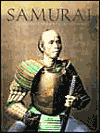When I picked up and began to leaf through Samurai: An Illustrated History by Mistuo Kure I was utterly captivated. Some two hundred fifty color photographs and illustrations of Japanese warriors across the ages are crammed into 192 (large) pages of text. Many of the photos come from historical re-enactments in Japan, and they are vivid, detailed, beautifully reproduced, and for the most part accurate. Unfortunately, the same cannot be said for the brief text. Although the author hopes “that readers may find enough in these pages to suggest a new image of the samurai, modifying a picture which has been distorted by romanticism,” and he references much of the current scholarship in the field, all he has accomplished is the pasting of a few newly uncovered facts onto time-worn conceptions of the history of the samurai.
Mind you, this is not something that I would notice all by myself (especially besotted by the photos as I am); I’m no specialist in Japanese medieval history. But I know someone who is, so I asked Dr. Karl Friday for his opinion of the history presented in this book. He replied:
Kure has read Takahashi Masaaki, Kawaii Yasushi, Fukuda Toyohiko, Suzuki Masaya, and other recent work on samurai warfare (including my Hired Swords, which is cited in the bibliography of his other picture book), but too often he’s completely missed the real importance of what the new scholarship is saying, and how it fits into (and changes) the big picture. This sort of problem is common in books by amateur historians (Kure is a physician, not a scholar). The basic cause is researching too narrowly–reading very specialized works on the topic under study, without sufficient grounding in the broader context. In this case, Kure clearly does not understand the socio-political backdrop against which the new scholarship he’s read is set. As a result, he’s picked up bits and pieces of details and incorporated them, but his general conception of developments–the framework in which he sets everything–is still the same story you find in old textbooks. He’s also ignored some of the key scholarship of the past decade or so–including Kondo Yoshikazu’s revisionist (but unanimously well-received) work on arms and armor. All in all, this is the sort of thing that drives historians crazy.
In short, according to Dr. Friday, “Kure’s history is full of (what all specialists today consider) old canards and other egregious misconceptions concerning Heian, medieval and early modern history.”
So why, you may ask, given Koryu.com’s well-established stance regarding the spread of accurate and authentic information, would I dare call this book to your attention? Basically, it is the photos, and the line drawings, which were done by noted and respected historian, Sasama Yoshihiko. They are simply superb, and worth, in my opinion, the price of the book. Just don’t take the history presented herein too seriously. In the end, this book is a perfect example of how easily misinformation on Japanese warriors can become widespread; don’t fall into the trap. For accurate history on the samurai, read Friday, Thomas Conlan, Jeffrey Mass, and Paul Varley (Marius Jansen’s Warrior Rule in Japan, an anthology of articles from the Cambridge History of Japan, is a good place to start). Then feast, eyes wide open, on this book for the sheer delight of the photographs.

